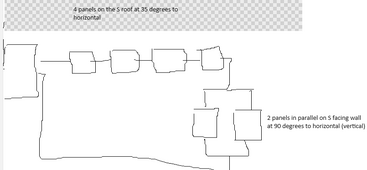Guy from Glasgow
New Member
I think i do not have enough panels (4 panels with max working voltage of 29.7V) on my south facing roof for my invertor.
Invertor is Growatt SPH3600TL BL-UP - and invertors working voltage is 120V-450V.
So ATM my installer connected 4 panles from straight East roof with 4 panels from straight south roof.
Power produced seems to drop badly (by factor of 3-4 probably) in the afternoon when E panels are not getting any direct sunshine.
Invertor has 2 MPPTs (120V min voltage).
Question:
I have plenty of space on the south and East facing walls.
So i am thinking of installing a panel or two on each of those walls vertically (flat on the wall) and have 2 strings of 5 or 6 panels each connectd to separate E and S MPPTs?
To be clear: straight S string will have 4 panels mounted at 35 dgree angle and 1 mounted vertically on South wall.
E string will have 4 panels at 35 degree angle roof + 1 string mounted vertically on E facing Wall.
I am in Scotland 56 degrees North so in winter sun is very low at 10 degrees and in summer not higher than 57 degrees on 22 of June.
A coludy day may be a problem - when most of the diffused light is coming down from the scky (almost vertically?)???
Wonder if anyone had to do this before? How bad compared with say 35 degrees south facing roof?
Probably better than 4 straight E + 4 straight S in one string?
Thanks!
Invertor is Growatt SPH3600TL BL-UP - and invertors working voltage is 120V-450V.
So ATM my installer connected 4 panles from straight East roof with 4 panels from straight south roof.
Power produced seems to drop badly (by factor of 3-4 probably) in the afternoon when E panels are not getting any direct sunshine.
Invertor has 2 MPPTs (120V min voltage).
Question:
I have plenty of space on the south and East facing walls.
So i am thinking of installing a panel or two on each of those walls vertically (flat on the wall) and have 2 strings of 5 or 6 panels each connectd to separate E and S MPPTs?
To be clear: straight S string will have 4 panels mounted at 35 dgree angle and 1 mounted vertically on South wall.
E string will have 4 panels at 35 degree angle roof + 1 string mounted vertically on E facing Wall.
I am in Scotland 56 degrees North so in winter sun is very low at 10 degrees and in summer not higher than 57 degrees on 22 of June.
A coludy day may be a problem - when most of the diffused light is coming down from the scky (almost vertically?)???
Wonder if anyone had to do this before? How bad compared with say 35 degrees south facing roof?
Probably better than 4 straight E + 4 straight S in one string?
Thanks!




